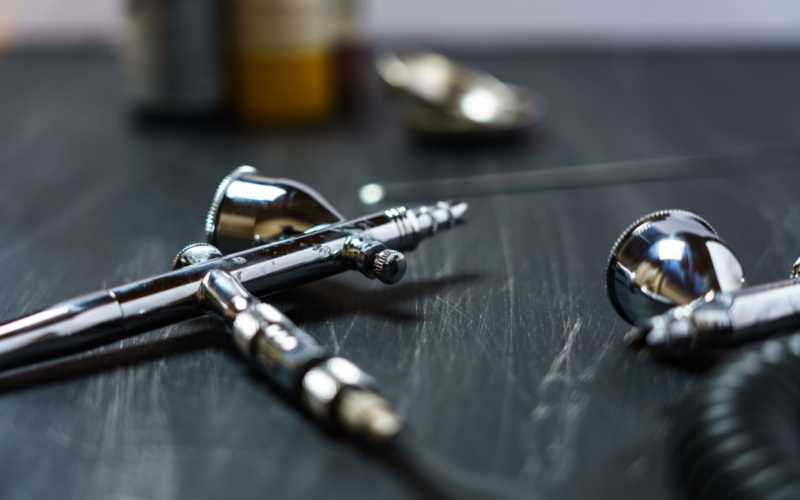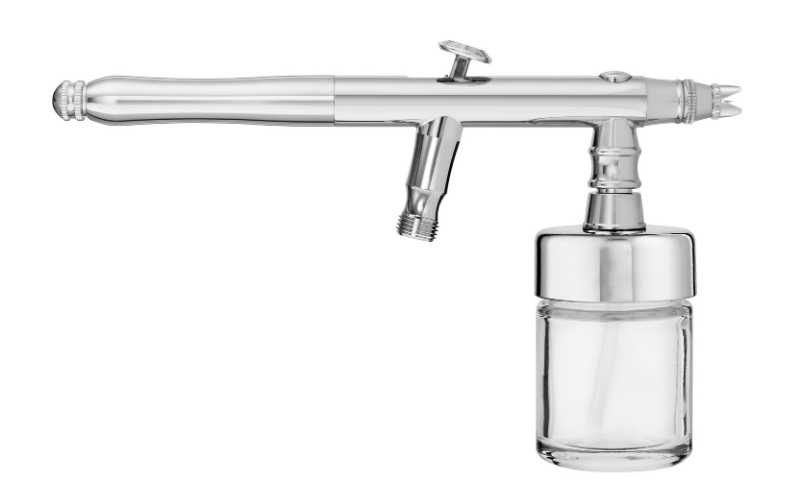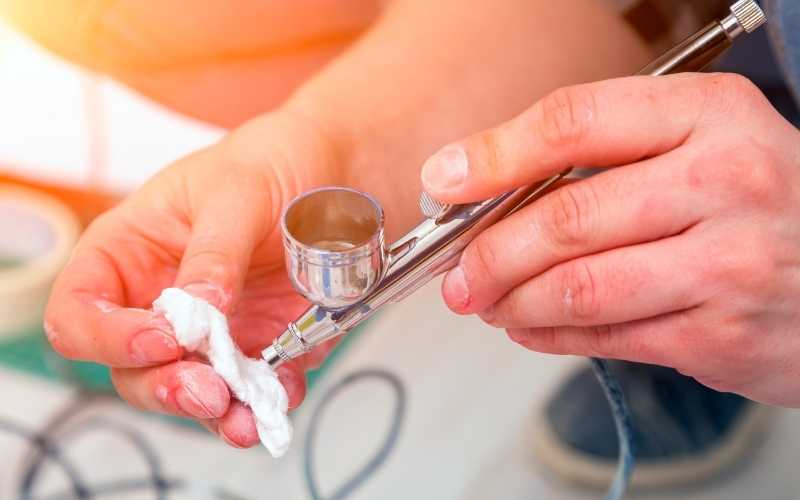Airbrushes have been around for quite some time, but they have never been more popular and useful than they are today.
In its basic form, an airbrush is a small pneumatic or air-operated stylus-looking tool you can use to spray various coloring media such as paint, dye, ink, and foundation through a process known as nebulization.
Nebulization. That’s a big word. But just think of an airbrush as a tool that uses compressed air to spread paint or color into very tiny particles allowing the user to create beautiful and complex artwork with it.
This makes it a very special tool designed specifically for artists and designers such as automobile customizers, toy and model builders, and even makeup artists to express their crafts in ways never seen before.
Today, airbrushes are finding more and more applications in different fields, in the movie industry and so on.
But before I go on to talk more about the different applications, let’s talk about how the tool works and how you can use it properly.

Table of Contents
How Airbrushes Work
Like I mentioned earlier, airbrushes are pneumatic or air-powered tools. The name “air-brush” say’s ti all.
Therefore, just like any other pneumatic tool, you need a source of compressed air to make it work. Most likely, if you’re buying an airbrush, then you’re also going to be buying a compatible air compressor if you don’t already have one.
As for the airbrush itself, it works just like any other paint sprayer but in a more miniature scale.
It works by passing a stream of fast moving air from the air compressor through a venturi or vacuum ejector. This air creates an air pressure difference which allows paint to be pulled from an interconnected reservoir at normal atmospheric pressure.
The paint gets atomized by the high velocity of the compressed air as it blows past the tiny tip onto the paper or canvas you’re working on.
They comes equipped with a variable trigger which allows the artist to control the amount of paint used by opening or moving a very fine tapered needle inside the tool.
The smoothness of the painting or artwork created with it depends on the fineness or degree of atomization of the paint used.
Related: Tips For Choosing An Air Compressor For Spray Painting
Types Of Airbrushes
Airbrushes come in different types and configurations. Because of that, they’re classified based on three different characteristics or features.
First of all, they’re classified according to how the paint flow is triggered by the user. Secondly, they’re classified or grouped according to how the paint is fed into the airbrush.
Lastly, they’re classified according to how the paint and air mix together as it comes out of the tip.
Type Of Airbrushes Base On Trigger System
Single Action Trigger
A single-action trigger airbrush is one of the most popular and less expensive type you can ever get your hands on today.
This is because, the mechanism behind how it works is quite simple or the simplest of all the two trigger mechanisms.
With a single action trigger, air and color flow to the tip with a single action of simply depressing the trigger.
To adjust the color flow volume and spray pattern of a single action trigger airbrush, you need to turn the tip for an external mix airbrush.
For a single action trigger of an internal mix airbrush, you need to turn a needle setting dial to adjust the color or paint flow volume and spray pattern.
If you’re just trying to add a uniform coat of color to a surface, single-action airbrushes are ideal. They’re simpler to use compared to dual-action types and are even cheaper when it comes to cost of purchase.
Although very cheap and simple to use, the major negative of a single-action airbrush is that it’s not ideal for artists to carry out more complex artworks that involves blending of different colors.
That is where the dual-action model shines.
Dual-Action
With a dual-action airbrush, you can adjust or control the release of air and color/paint right at the trigger by depressing the trigger to release/adjust the air and sliding the trigger back and forth to release/adjust the color.
Using a dual-action airbrush allows you to adjust color/paint volume flow without stopping to adjust the spray pattern of the airbrush. The color flow and the air flow can be adjusted right at the trigger, coupled this with the users’ adjustment of distance for the spray surface allows the user to carry out really complex artworks.
Using it is not as simple as using a single-action airbrush. It requires some amount of practice for someone to master using the trigger and controlling the tool at the same time.
However, it offers skilled artists a very versatile tool they can use when creating really complex artistic designs as long as they know how to handle the tool.
Types Of Airbrushes Base On Paint Feed System
When classified based on paint feed system, they’re divided into Gravity feed, Side feed and Bottom feed airbrushes.
Gravity Feed System

With a gravity feed airbrush, the reservoir that contains the paint or color is mounted on top.
When in use, the paint inside the reservoir is drawn in with the assistance of gravity, thus requiring less air pressure from the air compressor to operate a gravity feed type.
The first advantage to the gravity feed system is that which I’ve already mentioned. Less air pressure is required to get the paint flowing.
It also allows the user to create more detailed work as the less little air pressure used leads to more atomization of the paint and very little chance of overspray occurring.
Side Feed System

One of the major advantage of a side feed system is that it allows you to choose an airbrush that works well whether you’re a right handed user or a left handed user.
The side feed system has the paint reservoir at the side of the airbrush, with some having the ability to rotate the paint cup, allowing the user the most convenient angle he/she wishes to work.
A side feed system also offers the user more visibility, because with no paint cup at the top, you can easily see what you’re working on through the top.
Another major advantage is that you can often use different sizes of paint cups or bottles with it.
This makes the airbrush very versatile allowing you to tackle fine detailed work using small cups and using larger cups or bottles for projects where large areas needs to be covered with paint.
Depending on the design of the cup, side feed airbrushes can also work as a gravity feed or siphon/suction feed airbrush.
If the connector to the airbrush is at the bottom of the cup, then the cup can be rotated upwards above the handle, and feeding in paint into the airbrush gets some assistance from gravity.
On the other hand, if the connector of the cup is at the middle or close to the top of the cup, then the cup just sits at the side when connected and it kind of relies on the siphon feed system, requiring more air pressure from the air compressor to pull in paint from the cup just like a bottom feed airbrush.
Related: 20 Tools For Painting A Room You Should Know
Bottom Feed

Bottom feed airbrushes, as you may already know or might have guessed, have their paint cups or reservoirs connected at the bottom or underneath.
This offers users a better line of site when using it as there’s no cup at the top of the airbrush.
They however require more air pressure to draw up or siphon the paint from the cup underneath it. That’s why they’re also called Siphon feed or Suction feed.
Bottom or siphon feed airbrushes usually have larger capacity paint cups, and thus are usually ideal for carrying out large scale projects that will require the user to spray a large amount of paint, such as automotive paint jobs.
Types of Airbrushes Base on Paint Mix Point
Internal Mix
With an internal mix airbrush, the compressed air atomizes the paint inside the tool before coming out of the tip.
This creates a finer atomized mist of paint as it exits the tip. Internal mix airbrushes are more expensive and are better suited for detailed work as the paint comes out more atomized.
External Mix
When it comes to external mix airbrushes, the paint and air does not mix inside the tool. The compressed air and paint exits the tip separately before the paint mixes with the air and gets atomized just outside the airbrush.
The atomization here is larger or more coarse and generally not suitable for handling detailed work. Instead, it’s suitable for use with more viscous paints and when a large area needs to be covered with the paint.
Uses and Applications of Airbrushes

Creating high quality art and illustrations
Painting murals
Retouching of photos
Applying makeup / Finger nail art
Automotive paint job
Applying temporary tattoos
Cloth art/design
Street art Airbrush tanning


Good write-up. I’ll like to contribute to the uses of this tool. The air brush tool is also used in cake decorating/painting, leaving one with a very natural and professional look.
You’re right Maureen.
I’ll add that to the article.
I need a large airbrush to paint a trellis motorcycle frame and rhe motor that has a lot of small compartments (Ducati). The fan can be 3 to 4 inches footbal shape. What are my options? Thank you.
You can go for the Iwata Eclipse HP-CS airbrush featured in this article. It’s a good airbrush that’s ideal for painting small details like your motor that has small compartments, and also for covering large areas with paint like your motorcycle frame.